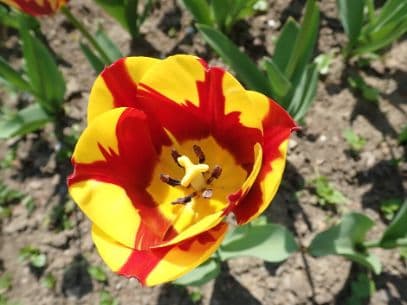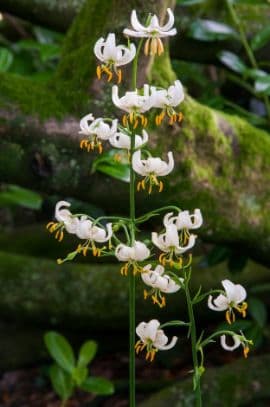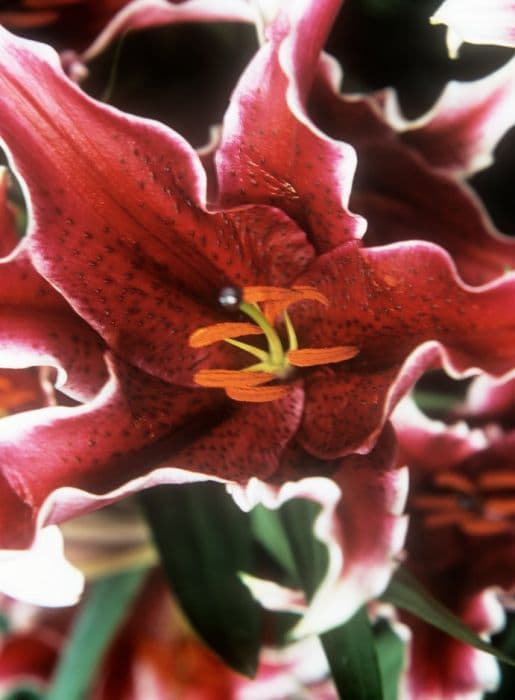Tulip Tulipa 'Helmar' (3)

ABOUT
Tulipa 'Helmar' is a striking variety of tulip known for its bold and dramatic coloration. This plant produces beautiful cup-shaped flowers that are a vivid yellow, with each petal featuring a strong flame of deep red that extends from the base towards the edges, creating a dramatic contrast reminiscent of licking flames. The petals may have a slight curl at the edges, adding to their allure. The leaves of this tulip are a rich green, broad and strappy, providing a perfect backdrop to the colorful blooms. Tulipa 'Helmar' flowers have six petals that are sturdy and well-formed. This plant's blooms are typically seen in the spring, showcasing their fiery display atop the foliage. The flowers are carried on strong, upright stems that hold them aloft with presence and poise. Tulipa 'Helmar' is indeed a showstopper in any garden with its unique pattern and vibrant colors that can make it a focal point of any springtime display.
About this plant
 Names
NamesFamily
Liliaceae
Synonyms
Helmar Tulip, Helmar Triumph Tulip
Common names
Tulipa 'Helmar'
 Toxicity
ToxicityTo humans
The tulip is known to have allergenic lactones and alkaloids, primarily concentrated in the bulb. If ingested, tulip bulbs can cause symptoms such as nausea, vomiting, and diarrhea. Some individuals may suffer from dermatitis following handling of the bulbs due to the allergenic properties of the lactones. It's important to avoid ingesting any part of the tulip plant, especially the bulbs, to prevent the possibility of poisoning.
To pets
The tulip is toxic to pets, including dogs and cats. The plant contains compounds such as allergenic lactones and glycosides, which are concentrated in the bulb. If a pet consumes any part of a tulip, but especially the bulb, they may exhibit symptoms such as vomiting, diarrhea, drooling, or even depression. Severe cases of tulip ingestion can lead to an increased heart rate and changes in respiration. If you suspect your pet has ingested tulip bulbs, it is crucial to contact a veterinarian immediately.
 Characteristics
CharacteristicsLife cycle
Perennials
Foliage type
Deciduous
Color of leaves
Green
Flower color
Yellow
Height
1-2 feet (30-60 cm)
Spread
0-1 feet (0-30 cm)
Plant type
Bulb
Hardiness zones
3
Native area
Central Asia
Benefits
 General Benefits
General Benefits- Aesthetic Appeal: Tulips add vibrant color and visual interest to gardens and landscapes.
- Ease of Growing: They are relatively easy to cultivate and can thrive in a variety of soil types.
- Pollinator Attraction: Tulips can attract bees and other beneficial insects to the garden, which is important for pollination.
- Seasonal Interest: Tulips have a specific blooming period that heralds the arrival of spring, providing early-season color.
- Versatility in Landscaping: They can be planted in beds, borders, containers, and even as cut flowers for indoor decoration.
- Diversity in Design: Available in a range of colors and forms, they offer numerous possibilities for garden design themes.
- Suitable for Cold Climates: Tulips are cold-hardy, making them suitable for gardens in cooler regions.
 Medical Properties
Medical PropertiesThis plant is not used for medical purposes.
 Air-purifying Qualities
Air-purifying QualitiesThis plant is not specifically known for air purifying qualities.
 Other Uses
Other Uses- Tulip petals can be used to create natural dyes, with 'Helmar' tulips offering a vibrant yellow color that can dye fabrics and even easter eggs.
- The sturdy stems of tulips can be used in floral arrangements to support lighter, more delicate flowers.
- The bulbs of tulips can be used in a "forcing" project to bloom inside during winter, adding a splash of color to indoor environments.
- Tulip flowers can be used in perfumery as a source of fragrance, especially in artisan or niche perfumes.
- The unique pattern of 'Helmar' tulips can be used as inspiration for artists and designers in creating patterns for textiles and wallpapers.
- Tulip blossoms can be crystallized with sugar and used as edible decorations for cakes and desserts.
- Pressed tulip flowers, including 'Helmar' tulips, can be used to create botanical art or to adorn handmade greeting cards.
- During educational activities, tulip plants can be used to teach children about plant biology and the lifecycle of flowers.
- The bloom of tulips, including 'Helmar', can be used in photography for practice with macro and floral subjects.
- Used as a natural pest deterrent, certain tulip varieties are known to repel insects and can be planted as companion plants in gardens.
Interesting Facts
 Feng Shui
Feng ShuiThe Tulip is not used in Feng Shui practice.
 Zodiac Sign Compitability
Zodiac Sign CompitabilityThe Tulip is not used in astrology practice.
 Plant Symbolism
Plant Symbolism- Perfect Love: The tulip in general is a symbol of perfect, deep, or enduring love, thanks to its association with Turkish and Persian legends about love.
- Rebirth: The tulip's beautiful display each spring after a dormant winter period is often associated with the idea of rebirth and renewal.
- Charity: Tulips can represent charity in the language of flowers due to their large, open blooms and history of being cultivated for pleasure and giving.
- Forgiveness: The tulip can also express feelings of forgiveness or an apology, making it an appropriate choice to include in a bouquet meant to mend relationships.
- Legend has it: While not directly a symbolic meaning, the specific coloration of the 'Helmar' tulip, with its bold strokes of yellow on red, could be seen as representing a striking or passionate statement, perhaps in love or creativity.
 Water
WaterTulips generally require watering during their growing season if the weather is very dry. For the Tulipa 'Helmar', also known simply as tulips, you should water them thoroughly when the soil feels dry to the touch, which may be once a week depending on weather conditions. Apply about an inch of water to ensure that it reaches the roots, which roughly translates to 0.6 gallons per square yard. Avoid watering too frequently to prevent bulb rot; tulips prefer to be on the drier side rather than too wet. Once the tulips have finished blooming and the foliage has died back, you can reduce watering as the plant goes dormant.
 Light
LightTulips, including the Tulipa 'Helmar', thrive in full sun to light shade. The best spot for these tulips would be an area where they can receive at least six hours of direct sunlight each day. They can tolerate light shade, but the blooms may not be as robust, so aim for a space that gets plenty of sunshine.
 Temperature
TemperatureTulips prefer a cooler climate and are hardy in a range of temperatures. The ideal temperature conditions for growing Tulipa 'Helmar' range from 40 to 70 degrees Fahrenheit. They can tolerate some frost and survive minimum temperatures down to around 20 degrees Fahrenheit. It's important to provide a chilling period at 35-45 degrees Fahrenheit before planting, which is necessary for the bulbs to set blooms.
 Pruning
PruningTulips, such as the Tulipa 'Helmar', don't require traditional pruning but do benefit from the removal of spent flowers. Deadheading after blooms fade helps direct energy to the bulb rather than seed production. Leave the foliage intact until it turns yellow and dies back naturally, as this allows the plant to photosynthesize and store energy for the next season. This cleanup typically takes place in late spring or early summer.
 Cleaning
CleaningNot needed
 Soil
SoilTulips thrive in a well-drained, sandy loam soil with moderate fertility. A good mix for 'Helmar' tulips is three parts garden soil, two parts compost, and one part coarse sand or perlite. The ideal soil pH for tulips should be between 6.0 and 7.0 to ensure proper growth and flower development.
 Repotting
RepottingTulips, including the 'Helmar' variety, are typically grown from bulbs that need to be planted in the ground or outdoor containers in the fall. Repotting is not a common practice as they need to be replaced every few years as their flowering performance can diminish with age.
 Humidity & Misting
Humidity & MistingTulips such as 'Helmar' prefer outdoor conditions and are not highly dependent on atmospheric humidity. They are tolerant of a range of humidity levels as long as they have good soil drainage and proper care.
 Suitable locations
Suitable locationsIndoor
Place 'Helmar' tulip bulbs in cool, well-lit, ventilated areas indoors.
Outdoor
Plant 'Helmar' tulip bulbs in autumn, full sun to partial shade.
Hardiness zone
3-8 USDA
 Life cycle
Life cycleThe life of a Tulipa 'Helmar', commonly known as the 'Helmar' tulip, begins with a dormant bulb planted in autumn before the freeze. The bulb roots firmly in the soil, drawing nutrients and storing energy for growth. As temperatures warm in spring, the bulb breaks dormancy, sprouting green shoots that develop into sturdy stems and leaves. Following the foliage growth, the tulip produces a striking yellow flower with red flames, usually blooming around mid to late spring. After flowering, the plant goes through a period of senescence as petals fall, leaves yellow, and the tulip redirects energy back into the bulb. The bulb then re-enters dormancy during the summer months, conserving energy for the next growing season.
 Propogation
PropogationPropogation time
Spring
Tulipa 'Helmar', commonly known as the Helmar tulip, is typically propagated through bulb division, a method that aligns with the natural reproductive cycle of the plant. The best time for dividing tulip bulbs is in the late summer or fall, once the foliage has died back but before the ground freezes. When the tulip has finished blooming and the foliage has yellowed, the bulbs can be carefully unearthed with a spade, ensuring a gentle lift to avoid damaging them. After lifting the bulbs, any offset bulbs that have formed at the base of the parent bulb can be gently separated. These offsets, or daughter bulbs, should be of a substantial size, roughly the size of a coin, to ensure successful growth when they are replanted. Once separated, the bulbs are then stored in a cool, dry place until the appropriate planting time in the fall. When replanting, it's essential to plant the bulbs at a depth three times their height to provide adequate insulation and support for the developing stem.





![Lily [Roselily Chelsea]](/_next/image?url=https%3A%2F%2Fplants-admin.emdemapps.com%2Fimages%2Fplants%2F%2Fimages%2F604b584f6f830.png&w=640&q=75)



